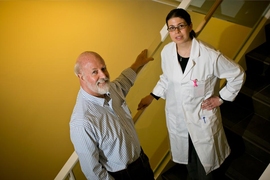When the National Academy of Sciences (NAS) released its Human Genome Editing Report last week, a wave of questions arose regarding the report’s scientific and clinical implications. The report, which outlines criteria that should be met before allowing clinical trials involving germline editing to go forward, was issued in response to the promising research and clinical opportunities associated with powerful genome-editing tools such as CRISPR/Cas9.
Richard O. Hynes is a Daniel K. Ludwig Professor for Cancer Research at MIT, a member of MIT's Koch Institute for Integrative Cancer Research, and a former director of the Koch Institute's predecessor, the MIT Center for Cancer Research. Hynes, a co-chair of the NAS study committee that created the report, sat down to shed additional light on the report’s recommendations and its impact on the future of genome editing.
Q: Why is a report like this needed now?
A: We are in the midst of an explosion of new research and clinical opportunities that can be enabled by genome-editing tools. Genome editing is now much easier, faster, cheaper, and more versatile than ever. Because this field is advancing so rapidly, the issues and concerns that genome editing raises needed to be seriously reviewed and addressed, alongside the development of the technology itself.
There are, of course, many technical questions — such as what risks exist, how to reduce them, and how to regulate the different ongoing applications — which need to be explored further, but there are plenty of societal questions as well. For example, should one allow “enhancement” or going beyond treatment and prevention of disease and disability? Should heritable germline editing be allowed, if and when it might become sufficiently reproducible, accurate, and safe? And if so, how would that affect societal attitudes toward disability, issues of equity and fairness, and concerns around creating a slippery slope that could lead to inappropriate applications?
The report’s committee represented four continents and included scientists, clinicians, ethicists, lawyers, and public engagement experts, among others. Each member offered a unique perspective on how oversight guidelines should be crafted and regulated and how to further public discussion. We believe the resulting recommendations will have universal applicability across multiple countries and cultures, and we recommend a set of principles that could be incorporated into the regulation and oversight in any country pursuing human genome editing.
Q: What are the report’s primary take-home points?
A: First, human genome editing in the contexts of basic laboratory research, and somatic gene therapy for the treatment and prevention of disease and disability are valuable and well-regulated. They should proceed under the existing oversight and regulatory norms.
Second, editing for purposes other than treatment or prevention of disease and disability should not be approved at this time. Public engagement and discussion on this topic should be actively promoted before advancing past these purposes, and specific funding should be allotted to support this.
Finally, while human heritable germline editing is not yet practicable and much further research is necessary before it could be considered for clinical trials, there are arguments for limited applications to prevent heritable disease should that become feasible. At the same time, there are technical, practical, societal, and ethical concerns that need to be addressed. The report lays out a set of stringent criteria that would need to be met for approval of any trial of heritable germline editing, and it recommends extensive public engagement in discussions about how to assess its implications before any such trials.
Q: Are there any misconceptions about the report that you would like to address?
A: Of course, there is always the potential for concern around these topics when they enter the public sphere, but this report is firmly grounded in existing ethical, scientific, and regulatory practices — and in consultation with the individuals and communities who will be directly affected by this technology. I would say that the committee is not opening the door to human genome editing, but we are, so to speak, removing the padlock pending possible new applications. Furthermore, the report is recommending human applications only for purposes of treatment and prevention of disease or disability and not for any applications that go beyond that, such as enhancements.
We limited our recommendations to this because of concerns about making unnecessary, potentially risky edits aimed to enhance human capacities beyond what is necessary to treat a life-threatening or debilitating condition. Enhancement is a topic that needs more discussion and public engagement to assess societal attitudes. At this time, we say no to any germline enhancements. If technology moves forward to enable the possibility, our current recommendation would be that it should be used to enable healthy babies, not “designer babies.” We also have confidence in the current systems of regulation and decision-making based on risk/benefit analysis but believe it should incorporate more engagement with public opinion.
Overall, we have been pleased with the coverage of the report so far, and the public seems to be excited about the major acceleration of our understanding of human biology. There is real potential to combat many diseases, such as cancer and thousands of genetically inherited diseases, which affect a significant number of people in the global population. Somatic editing is already in clinical trials, and many more are yet to come that we will learn a great deal from — particularly about efficacy, risks, and the impact of this modern form of gene therapy. Germline editing is not possible yet — probably not for several years — but it is time to think carefully about the implications while the technical aspects are still being explored, rather than waiting until the decisions as to whether or not to proceed are imminent.









